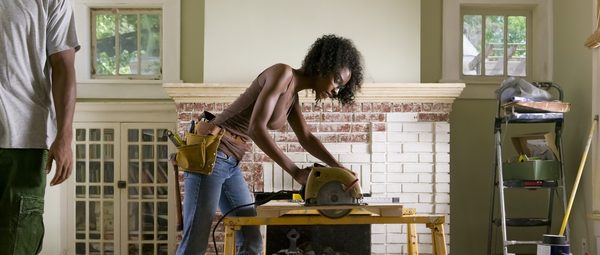203(k) and HomeStyle Loans: Buy, Renovate With One Mortgage

Some or all of the mortgage lenders featured on our site are advertising partners of NerdWallet, but this does not influence our evaluations, lender star ratings or the order in which lenders are listed on the page. Our opinions are our own. Here is a list of our partners.
You've been house hunting, but you can't find a place that's affordable and move-in ready. It's time to broaden your search to include fixer-uppers. You'll have more properties to choose from, and you can get a renovation loan that combines the purchase price with the cost of improvements.
Two options, the FHA 203(k) loan and the Fannie Mae HomeStyle loan, let you borrow money to buy a home and fix it up. And you may begin renovations right after closing the loan.
Work doesn't have to be major
Renovation loans give you more homebuying options by making it possible to buy fixer-uppers and do repairs immediately. The loans may pay for structural repairs, cosmetic renovations and in-between improvements.
“HomeStyle and 203(k) loans may pay for structural repairs, cosmetic renovations and in-between improvements.”
Structural repairs include work to make the home habitable. For example, replacing copper plumbing and electrical wires that were torn out while a house sat vacant. Adding a room counts as a structural renovation.
Cosmetic renovations include things like replacing outdated kitchen cabinets. An example of an in-between improvement is a roof replacement.
» MORE: How much house can you afford?
| Lender | APR | Interest rate | Mo. payment | Sort by |
|---|---|---|---|---|
203(k) and HomeStyle
Most renovation mortgages come in two types:
FHA 203(k) loans are mortgages insured by the Federal Housing Administration.
HomeStyle loans are mortgages guaranteed by Fannie Mae.
These two renovation loans share many similarities. Among them:
The money can be used for major structural repairs as well as for cosmetic renovations (or a combination).
All renovation work is done after the loan is closed, not before.
If you can’t occupy the home during renovations, you can add up to six months of mortgage payments to your loan amount so you pay the mortgage on the new house while you’re living elsewhere.
Renovation money is set aside in an escrow account, and contractors are paid in draws when they hit milestones in their work.
Minimum required down payments are based on either the total cost of the purchase plus renovations or on the expected appraised value of the home after the work is completed. Each loan uses a formula to decide which to use.
How 203(k) and HomeStyle differ
The differences in these loans are in how they are lenient and how they are strict.
FHA 203(k) loans are more lenient about the borrower's credit and more strict about the renovation work that can be done.
Fannie Mae HomeStyle mortgages are more strict about the borrower's credit and more lenient about the renovation work that can be done.
Here's how those differences shake out:
Credit scores: Borrowers with credit scores of 500 or higher may qualify for FHA 203(k) loans. For HomeStyle loans, the minimum credit score is 620.
Down payments: For 203(k) loans, the minimum down payment is 3.5% if your credit score is 580 or higher; it's 10% if your credit score is 500 to 579.
For HomeStyle, the minimum down payment is 3% if the home will be owner-occupied and at least one borrower is a first-time home buyer. There's an exception for HomeReady loans, which have income restrictions. Otherwise, the minimum down payment is 5%.
Allowed improvements: 203(k) loans can't be used to pay for work that the FHA deems luxuries. Examples include installing a new swimming pool, adding an outdoor hot tub or sauna or building an outdoor barbecue pit or fireplace. Repairing an existing swimming pool is allowed.
HomeStyle loans have few restrictions on improvements, other than that they "should be permanently affixed to the real property (either dwelling or land)," according to Fannie Mae guidelines. That means HomeStyle may pay for adding a new swimming pool or permanent landscaping.
Residence types: A 203(k) loan is for a primary residence. It can't pay for fixing up a vacation home or investment property. The home may be a single-family house, a condo or other home in a one- to four-unit structure or a qualified manufactured home. You may use a 203(k) standard mortgage to tear down a house and rebuild on the foundation.
HomeStyle can be used to renovate a second home or investment property. The home may be a one- to four-unit principal residence, a one-unit second home or investment property, a manufactured home or a unit in an eligible condominium or co-op. You cannot use HomeStyle to tear down and rebuild the home.
State of completion: With a 203(k) loan, the home has to have been completed for at least one year. A HomeStyle loan "may be used to complete the final work on a newly built home when the home is at least 90% complete," according to Fannie Mae's selling guide.
FHA 203(k) loans have two options
There are two flavors of 203(k) loan: limited and standard.
The 203(k) limited loan caps the cost of renovations to $35,000. It can't be used for structural repairs, such as adding a room or relocating load-bearing walls. There is no minimum cost of repairs.
The 203(k) standard loan allows for major structural work. Any project costing more than $35,000 must be a standard loan, whether or not it involves structural repairs. Total improvements must cost at least $5,000. A 203(k) standard loan requires working with a HUD consultant, who manages the project.
| Lender | APR | Interest rate | Mo. payment | Sort by |
|---|---|---|---|---|
Steps to take
After finding the house you want, the first step to getting a renovation loan is to apply with two or more lenders and compare their experience with these loans — their responses to your questions and their rates and fees. Once you choose a lender and decide the type of loan:
Hire a consultant if you're getting a 203(k) standard loan. The HUD website has a consultant search tool, and you should talk with your loan officer.
List the improvements you want to make, interview contractors and get cost estimates for the work.
Hire contractors.
Provide the contractors' estimates to the lender.
Close on the mortgage. Work may begin immediately after closing.


